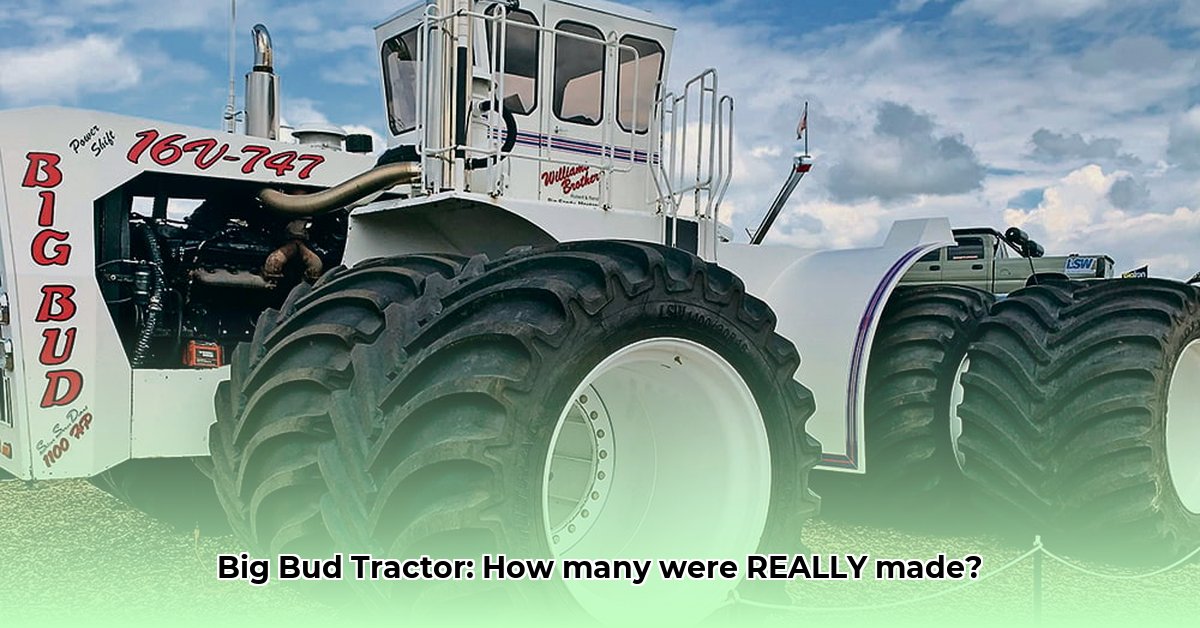
How Many Big Bud Tractors Were Made? A Surprisingly Small Number With a Large Impact
The Big Bud tractor. The name itself evokes images of a farming behemoth, a titan of the fields. But how many of these legendary machines were actually produced? While precise figures remain elusive, the story behind the Big Bud is far more captivating than a simple number. It's a tale of innovation, efficiency, and the complex interplay between agricultural progress and environmental responsibility. Estimates suggest approximately 747 Big Bud tractors were manufactured – a surprisingly small number considering its profound impact on farming practices. But why such a limited production run for a machine that revolutionized agriculture? For more on different tractor brands, see this helpful resource.
The Big Bud's Story: From Humble Beginnings to Farming Icon
The Big Bud’s development wasn't an overnight success. Born from a need to efficiently till vast expanses of land, its creation was a testament to American ingenuity. This wasn't about small family farms; the demand stemmed from large-scale operations needing maximum output in a rapidly evolving agricultural landscape. The result? A tractor so large it required two operators – one to steer, the other to manage the immense power. The design was revolutionary for its time. It boasted an incredibly powerful engine, a robust transmission built to handle immense torque, and a construction designed to endure the stresses of continuous heavy-duty fieldwork. Imagine the engineering marvel involved in creating something both immensely powerful and precise enough for seed planting.
A Few, But Mighty: Delving Into Production Numbers and Market Factors
Estimates of Big Bud production numbers converge around 747 units. This remarkably low figure, relative to its impact, can be attributed to several factors. The high cost of production—manufacturing such a specialized, massive machine was undeniably expensive—was a significant barrier. Moreover, the Big Bud’s specialized nature limited its market appeal; not every farm needed or could afford such a powerful, and expensive tool. Logistical challenges, from transportation to maintenance, also played a significant role. While revolutionary for some, the Big Bud's production was ultimately constrained by factors beyond sheer engineering prowess. Further complicating the precise count, the timeframe of its production is debated: some sources cite 1981, others 1992, highlighting the lack of comprehensive records on this niche agricultural machinery.
The Big Bud's Legacy: Increased Efficiency, but at What Environmental Cost?
The Big Bud’s impact on agriculture was undeniable. Its ability to quickly till massive acreage dramatically reduced labor costs and significantly increased output per unit of labor. The implications for agricultural production were profound. However, this productivity came with an unavoidable environmental cost. The considerable fuel consumption and resulting emissions raise serious concerns about its environmental footprint. The tractor's immense weight also led to soil compaction, negatively impacting soil health and long-term cultivation. These are crucial sustainability concerns largely overlooked during the Big Bud's heyday. Therefore, its legacy serves as a stark reminder of the unintended consequences that can accompany technological advancements, highlighting the need to critically evaluate the environmental impacts of agricultural innovations.
Re-evaluating Farming Practices: Lessons Learned from a Giant
The Big Bud's story isn't solely one of engineering innovation; it's a valuable case study in sustainable agriculture. Its relatively small production run and its significant environmental impact highlight the crucial need to re-evaluate our approach to large-scale farming. Striking a balance between feeding a growing global population and responsibly conserving our planet's resources is undeniably a critical challenge. The Big Bud's experience serves as a pivotal lesson: a powerful reminder that agricultural innovation must incorporate environmental responsibility and long-term sustainability.
The Future of Farming: A Sustainable Path Forward
While the Big Bud's era is largely over, the demand for efficient and innovative farming continues to grow. The quest for sustainable agricultural practices is ongoing; this pursuit requires incorporating environmental responsibility alongside productivity goals. The lessons gleaned from the Big Bud—both the successes and the environmental drawbacks—are now shaping the development of modern agricultural tools and machinery. The ongoing dialogue about these innovations will continue to be shaped by the historical context provided by the Big Bud and its surprisingly limited numbers.
How to Assess the Long-Term Economic Viability of Big Bud Tractors: A Comprehensive Look
The Big Bud’s lasting influence extends beyond its historical impact. Understanding its long-term economic viability involves a careful assessment of several key factors. How to assess the long-term economic viability of Big Bud tractors requires careful consideration of:
- High Initial Cost: The upfront investment is immensely high.
- Expensive Maintenance: Repair and upkeep costs are exceptionally high.
- Parts Availability: Specialization makes parts difficult to source, leading to potential downtime.
- Fuel Consumption: Big Buds are fuel-intensive, representing a considerable operating expense.
- Operating Life: While durable, repair costs can eventually exceed the initial investment.
- Scale of Operation: Big Buds are only economically viable on large, flat-land farms.
These factors must be weighed against potential benefits, including the high output in suitable settings and, less conventionally, the potential for resale to collectors.